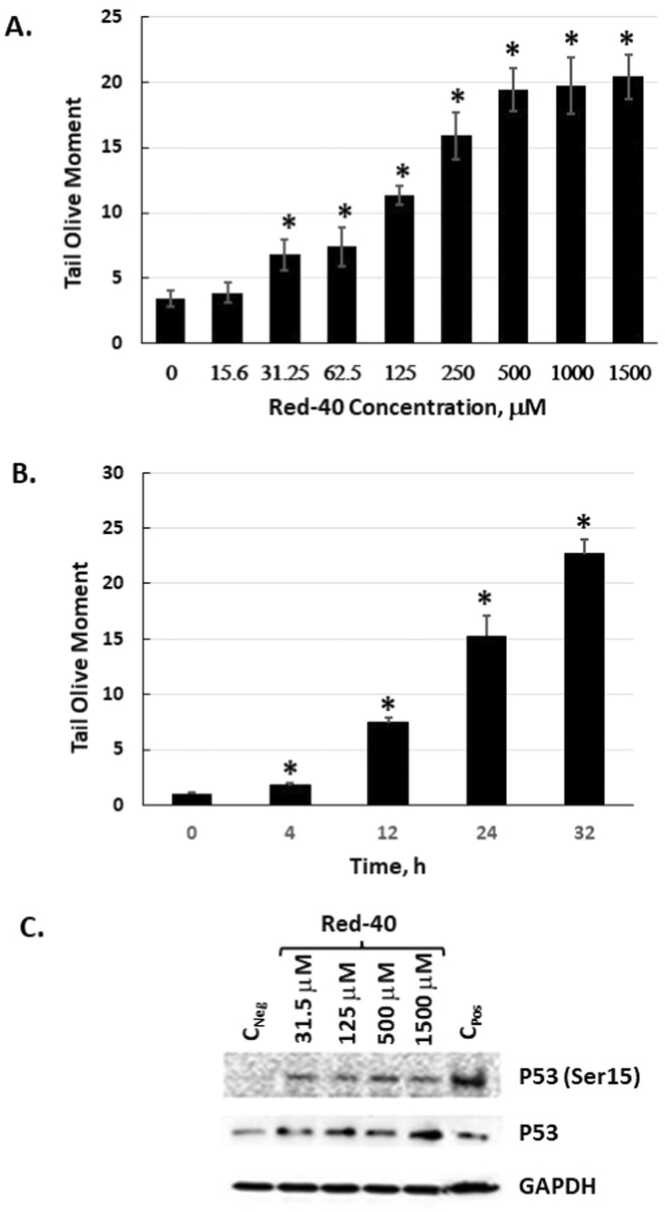Red 40, also known as Allura Red, is a synthetic food dye widely used to add color to a variety of processed foods, from candies and beverages to cereals and snacks. While it makes our food visually appealing, emerging research is raising concerns about its potential impact on our health. This article delves into the science behind these concerns, exploring why Red 40 might be bad for you based on recent studies.
Red 40 and DNA Damage: What the Science Says
One of the most alarming findings about Red 40 is its potential to damage DNA. A recent study investigated this effect both in cell cultures (in vitro) and in living organisms (in vivo). The results were concerning: Red 40 was shown to cause DNA damage in human colon cells in the lab.
Image: In vitro DNA damage caused by Red 40 in human colon cells, showing dose and time-dependent effects and increased levels of DNA damage markers.
To further investigate, researchers examined the effects of Red 40 on mice. They administered Red 40 at levels comparable to human consumption and found that it also caused DNA damage in the colon cells of these animals. This in vivo evidence strengthens the concern that Red 40 is not inert and can interact with our cells in harmful ways.
Image: In vivo DNA damage in mice colon cells after Red 40 exposure, demonstrating DNA damage at human-relevant dosage levels over different time periods.
DNA damage is a critical factor in the development of cancer. While this research doesn’t directly prove Red 40 causes cancer, it highlights a mechanism through which it could potentially increase cancer risk over time, particularly with chronic exposure.
Red 40, Inflammation, and Gut Health: A Troubling Connection
Beyond DNA damage, the study also explored the impact of Red 40 on inflammation and gut health, especially when combined with a high-fat diet, typical of a “Westernized” eating pattern. The results revealed a concerning synergy.
Mice consuming a high-fat diet along with Red 40 showed increased inflammation in their distal colon and rectum. This inflammation was not as pronounced in mice consuming Red 40 with a low-fat diet, suggesting that the combination of Red 40 and a diet high in fat may be particularly problematic.

Image: Inflammation markers and foci count in the colon of mice exposed to Red 40 with both low-fat and high-fat diets, highlighting increased inflammation in the distal colon and rectum, especially with high-fat diet.
Chronic low-grade inflammation is increasingly recognized as a significant factor in the development of colorectal cancer. By promoting inflammation in the colon, Red 40, especially in the context of a high-fat diet, could be contributing to an environment that is more conducive to cancer development.
Furthermore, the study investigated the gut microbiome – the complex community of bacteria living in our intestines. A healthy microbiome is crucial for overall health, including protecting against inflammation and disease. The researchers found that a high-fat diet significantly altered the gut microbiome in mice, reducing its diversity. Adding Red 40 to this high-fat diet further exacerbated these negative changes, leading to what’s known as gut dysbiosis – an imbalance in the gut bacteria.
Image: Analysis of microbial communities in mice on low-fat and high-fat diets, showing reduced diversity and altered composition in high-fat diet groups.
Image: Microbiome diversity analysis after Red 40 exposure, showing changes in microbial communities, particularly when combined with a high-fat diet.
Gut dysbiosis has been linked to a range of health problems, including increased susceptibility to inflammation and colorectal cancer. This suggests that Red 40, particularly in the context of a less healthy diet, could negatively impact gut health and indirectly contribute to disease risk.
Implications and What You Can Do
This research adds to a growing body of evidence suggesting that Red 40 is not simply a harmless coloring agent. It indicates that Red 40 can cause DNA damage, promote inflammation, and disrupt the gut microbiome, especially when combined with a high-fat diet. These are all factors that can increase the risk of colorectal cancer and potentially other health issues.
While more research, particularly in humans, is needed to fully understand the long-term effects of Red 40, this study provides compelling reasons to be mindful of your consumption of this food dye.
Here are some steps you can take:
- Read food labels: Check ingredient lists for “Red 40” or “Allura Red AC.”
- Reduce processed food intake: Processed foods are more likely to contain artificial food dyes. Focus on whole, unprocessed foods like fruits, vegetables, and lean proteins.
- Choose naturally colored options: When possible, opt for foods colored with natural ingredients instead of artificial dyes.
By making informed choices about the foods we eat, we can minimize our exposure to Red 40 and other potentially harmful food additives, prioritizing our long-term health and well-being.
Disclaimer: This article is for informational purposes only and does not provide medical advice. Consult with a healthcare professional for personalized dietary recommendations and health concerns.

